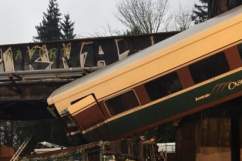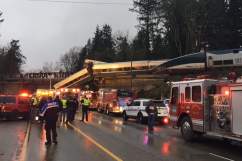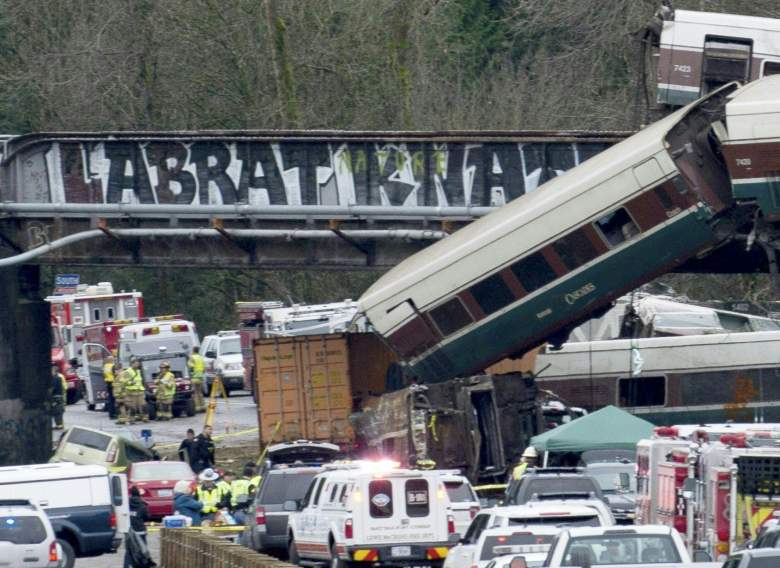
Getty The scene of a portion of the Interstate I-5 highway after an Amtrak high speed train derailled from an overpass early December 18, 2017 near the city of Tacoma, Washington.
At least three people are dead with several others injured following an Amtrak train’s derailment in Tacoma, Washington on December 18.
Which begs the question, could the tragedy have been prevented? Although the cause has not yet been confirmed, if speed was a factor, a potentially life-saving system called Positive Train Control (PTC) could have warned the conductor that he was going too fast. The train was not equipped with the technology.
According to a website which maps the location and speed derived from Amtrak’s train tracker app, the train was going 81.1 miles per hour just before it derailed on an overpass. That part of the track is designed for only 30-mile-an-hour speeds, according to NBC News. However, it’s important to note that the speed of the train at the time of derailment has not been confirmed at this time.
In 2008, a head-on crash involving a passenger and freight train in Los Angeles pushed Congress to mandate the use of PTC on systems of all major rail lines. While the changes originally required compliance by 2015, there have been hold-ups including high costs and technological obstacles.
Here’s how PTC works, according to a 2015 report by Forbes:
Before heading out on a trip, the train’s on-board computer downloads information about the route: posted speed limits & any known construction or hazards along the way.
During the journey, the train’s computer keeps in contact with dispatchers via signaling devices (antenna or GPS-based) along the route–sometimes these devices are even embedded in the tracks themselves. The ping points are connected to the train’s computer and dispatchers over a radio network—letting them know how fast the train is going, where it is, and whether or not it needs to slow down.
If the train is moving too fast, the computer on board the train warns the conductor.
In an emergency, the train’s on-board computer can override the conductor & apply the brakes.Besides slowing and stopping trains that are cruising too fast, Positive Train Control could also be used to prevent collisions between trains (since the system would know where each train is), keep trains from rolling into work zones, and stop trains from cruising through track signals left in the wrong position
“In late 2015, Congress extended the deadline by at least three years to December 31, 2018, with the possibility for two additional years if certain requirements are met,” The U.S.Department of Transportation Federal Railroad Administration (FRA) reported via their website. “The new legislation, the PTC Enforcement and Implementation Act, required that railroads submit a revised PTC Implementation Plan (PTCIP) by January 26, 2016, outlining when and how the railroad would have a system fully installed and activated.”
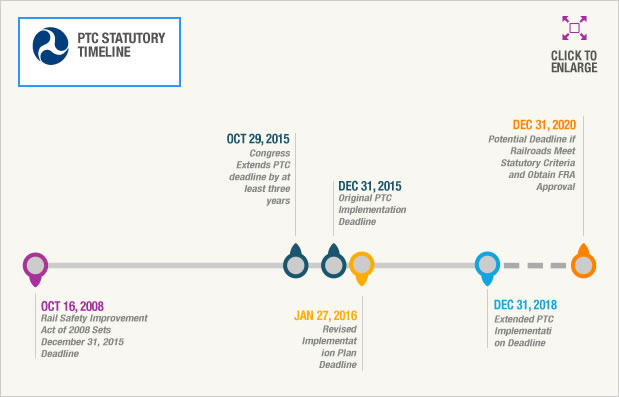
Federal Railroad AdministrationThe Positive Train Control’s Statuary Timeline is shown in the above diagram.
According to the site, “FRA continues to support railroads in implementing PTC, as well as rail carriers that are continuing to voluntarily implement PTC.” The assistance program includes the following, as reported by the governmental agency:
Providing more than $650 million to passenger railroads, including nearly $400 million in Recovery Act funding.
Issuing a nearly $1 billion loan to the Metropolitan Transportation Authority to implement PTC on the Long Island Rail Road and Metro-North Railroad.Building a PTC testbed in Pueblo, Colorado.
Making $25 million available in competitive grant funding to railroads, suppliers, and state and local governments.
Working directly with the Federal Communications Commission (FCC) and the Advisory Council on Historic Preservation to resolve issues related to spectrum use and improve the approval process for PTC communication towers.
Dedicating staff to continue work on PTC implementation in March 2010, including establishing a PTC task force.
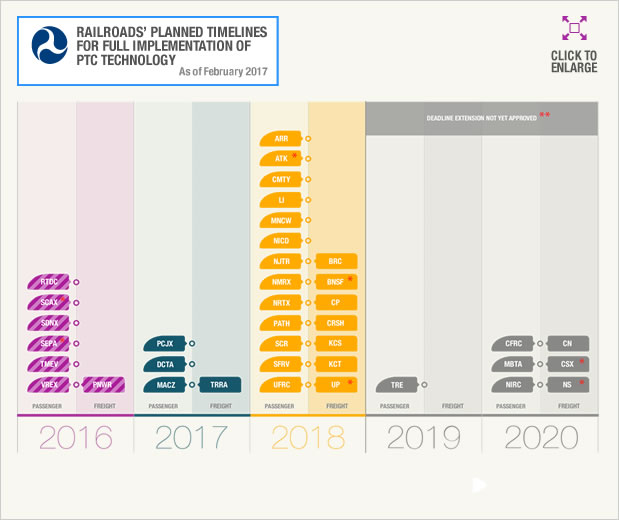
The graph above “displays a summary of when each railroad is targeted to complete its PTC implementation, as reported in the railroad’s revised PTC Implementation Plan,” the FRA explains on their website.
To check the current status of a specific railroad’s implementation of PTC, you can click here.
